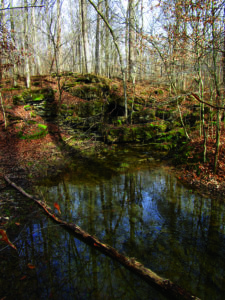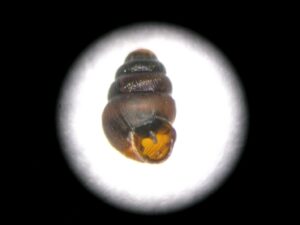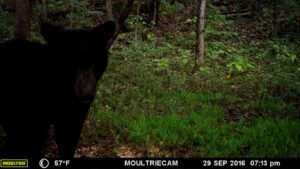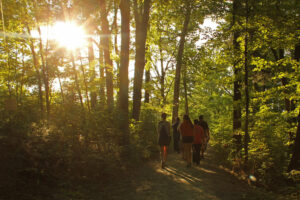 We often talk about Bernheim’s size in terms of acres or square miles – 16,137 acres or more than 25 square miles. That is larger than the island of Manhattan in New York City. It is larger than the next three largest park systems in our region combined. When you consider that a football field is a little over an acre, Bernheim is some 16,000 times the size of a football field.
We often talk about Bernheim’s size in terms of acres or square miles – 16,137 acres or more than 25 square miles. That is larger than the island of Manhattan in New York City. It is larger than the next three largest park systems in our region combined. When you consider that a football field is a little over an acre, Bernheim is some 16,000 times the size of a football field.
It is the largest privately held contiguous forest block in the Eastern United States, dedicated to conservation and education protected from what we call non-essential disturbances – logging, mineral extraction and other non-natural disturbances.
So why does that matter? How does a forest of this size benefit all of us?
 Clean air
Clean air
At 16, 137 acres, it is estimated there are over 3 million trees at Bernheim. Trees absorb odors and pollutants and filter particulates out of the air by trapping them on their leaves and bark. As many of us learned in science class, trees use a process called photosynthesis to convert carbon dioxide to oxygen. On average a single tree produces nearly 260 pounds of oxygen each year. By some estimates, two mature trees can provide enough oxygen for a family of four for a year. That is a lot of clean air for all of us to breathe – upwards of 780 million pounds of oxygen annually – enough for 6 million people – more than the population of the whole state of Kentucky.
 Clean Water
Clean Water
When just one inch of rain falls on an acre of land, it percolates through the soil, and flows out into the regional water sources. In 2017, 53.04 inches of rain fell at Bernheim, which equates to more than 27,000 gallons of water. That means more than 22 billion gallons of water are captured at Bernheim each year, all protected from development, pesticides and other environmental hazards, making it some of the cleanest water in the state. That water fills Bernheim’s ponds, lakes, wetlands and the headwaters of 13 streams – streams that feed the entire Salt River Basin (including the Rolling Fork, Beech Fork and Salt Rivers), providing valuable aquatic habitat for wildlife and an essential natural resource for us all. It is enough clean water to fill more than 34,000 Olympic sized swimming pools or nearly 70 percent of the water the Louisville Water Company supplies in a year.

A Refuge for Wildlife
With more than 50,000 acres of forests lost to development each year in Kentucky, natural spaces for wildlife to flourish continue to become more scarce. A protected forest of Bernheim’s size allows for unmatched biodiversity. More than 2,100 unique species live or take refuge at Bernheim. Twelve of Kentucky’s 14 bat species, including the endangered Indiana bat, use sections of Bernheim to feed, live in the winter and care for their young pups. Countless species of snails, slugs and micro-snails make Bernheim the most diverse snail site in the state. Even just in recent months, we discovered two new snail species, the bluff vertigo and the hidden spring snail.
 Turning from some the smallest of creatures to the largest, in the summer of 2016, we had the first confirmed black bear sighting in over 100 years. Additionally, we have tracked the return of Harper, the Golden Eagle for the fifth consecutive year, in addition to an additional golden eagle, a possible mate for Harper. That barely scratches the surface of the rich story of Bernheim’s wildlife, a veritable living laboratory that attracts researchers from across the country, seeking knowledge about the natural world.
Turning from some the smallest of creatures to the largest, in the summer of 2016, we had the first confirmed black bear sighting in over 100 years. Additionally, we have tracked the return of Harper, the Golden Eagle for the fifth consecutive year, in addition to an additional golden eagle, a possible mate for Harper. That barely scratches the surface of the rich story of Bernheim’s wildlife, a veritable living laboratory that attracts researchers from across the country, seeking knowledge about the natural world.
Quality of Place & the Economy
 You don’t have to be a researcher to discover, learn and connect with nature at Bernheim. Over 300,000 visitors do that every year. Whether it is hiking, fishing, enjoying one of our many programs or events, taking in our public art or just unplugging from the frenetic world in which we all seem to live, Bernheim provides each visitor with an experience like no other. It is a destination that brings people back year after year – a benefit to our local economy which should not be underestimated.
You don’t have to be a researcher to discover, learn and connect with nature at Bernheim. Over 300,000 visitors do that every year. Whether it is hiking, fishing, enjoying one of our many programs or events, taking in our public art or just unplugging from the frenetic world in which we all seem to live, Bernheim provides each visitor with an experience like no other. It is a destination that brings people back year after year – a benefit to our local economy which should not be underestimated.
Sitting on the western edge of the Bourbon Trail, Bernheim provides a picturesque backdrop that adds to the appeal of bourbon tourism which attracts nearly a million people each year. Bernheim’s picturesque beauty and clean water certainly contribute to the success of this famed Kentucky spirit, which seems only fitting since our founder, I.W. Bernheim made his fortune in the whiskey business. And it is not just the Bourbon industry that benefits from Bernheim. Economic developers throughout the region leverage Bernheim as a business and talent attraction tool – a destination that enhances our region’s quality of place.
90 years ago, Mr. Bernheim left us all an incredible treasure of an unmatched scale – one that provides the air we breathe; the water upon which we and wildlife depend, and a place that contributes to our economic prosperity and personal well-being. In this case, size does matter.
 In 2019, Bernheim celebrates 90 years of connecting people with nature. At over 25 square miles, Bernheim is the largest privately held forest dedicated to conservation and education in the region. Our arboretum is home to plant collections of over 8,000 varieties, public art, and educational programming for thousands of students. Our pristine forest hosts hikers and outdoor adventures alongside research and conservation projects which will serve to protect the environment for future generations.
In 2019, Bernheim celebrates 90 years of connecting people with nature. At over 25 square miles, Bernheim is the largest privately held forest dedicated to conservation and education in the region. Our arboretum is home to plant collections of over 8,000 varieties, public art, and educational programming for thousands of students. Our pristine forest hosts hikers and outdoor adventures alongside research and conservation projects which will serve to protect the environment for future generations.
As a 100% member and donor supported organization, we could not fulfill this important mission without you. We hope you’ll continue to support our efforts throughout the next 90 years. Join or donate by clicking here.

